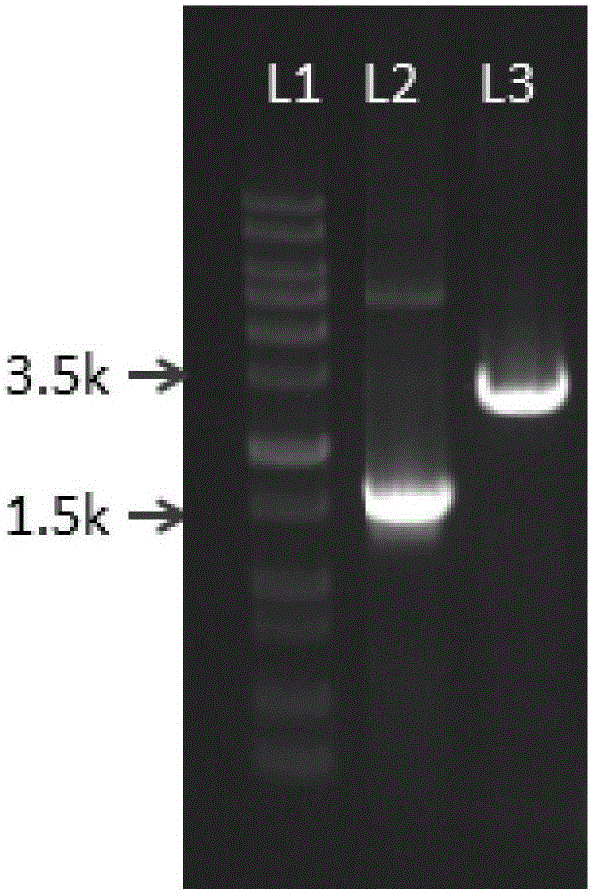Genetic engineering strain for producing phenazine-1-carboxylic acid and application of genetic engineering strain
A technology of genetically engineering strains and genes, applied in the field of bioengineering, can solve the problems of complex metabolites, difficulty in strain transformation, pathogenicity of strains, etc., and achieve the effects of high fermentation level, easy separation and extraction, and fewer species.
- Summary
- Abstract
- Description
- Claims
- Application Information
AI Technical Summary
Problems solved by technology
Method used
Image
Examples
Embodiment 1
[0045] Example 1 Construction of in vitro mutant of phzH gene-insertion mutation
[0046] Using the pBS(kan) plasmid as a template, the kanna resistance gene kan was amplified by PCR. Primers were designed according to the phzH gene sequence in the Pseudomonas chloropinus HT66 genome,
[0047] 5'-TT AAGCTT ACCCAGCCGATGGTCTATCGCTTTG-3' (HindIII, such as SEQ ID NO.3) and
[0048] 5'-AA GAGCTC CGCGATAGCCGTGAGGGTGGTGGAGT (SacI, such as SEQ ID NO. 4). Using the HT66 gene as a template, the phzH gene was amplified by PCR, digested with HindIII and SacI, and cloned into the same site of the pEX18Tc plasmid to obtain the recombinant plasmid pEX18Tc-phzH. Transformed into E.coliDH5α competent cells to make them resistant to tetracycline.
[0049] Recombinant plasmid pEX18Tc-phzH and Kanna resistance gene kan were respectively digested with SphI, recovered and ligated with T4 ligase. The ligation product was directly transformed into E.coliDH5α competent cells by heat shock at...
Embodiment 2
[0051] Embodiment 2, Construction of in vitro mutants of phzH gene-scarless knockout
[0052] Design primers according to the phzH and upstream and downstream sequences in the genome of Pseudomonas chloropinus HT66, upstream
[0053] CG GGATCC CGACGGGGGACCATCGTTCTAT-3' (BamHI, such as SEQ ID NO.5) and
[0054] 5'-ATTCATTGAGGCACGCCAAG-3' (such as SEQ ID NO.6), downstream
[0055] 5'-CTTGGCGTGCCTCAATGAATTTGGATCTCCTGCCGCTTTT-3' (such as SEQ ID NO.7) and 5'-CCC AAGCTT GACCTTGCAGGTCGGTGCGATA-3' (HindIII, such as SEQ ID NO.8), uses the genomic DNA as a template to amplify the corresponding fragment in the genome. The upstream and downstream PCR products were ligated by fusion PCR, and the fusion PCR product and the pK18mobsacB vector were digested with BamHI and HindIII respectively, recovered through the column, and ligated with T4 ligase to obtain in vitro mutant plasmids and transform Escherichia coli S17.
[0056] The S17 strain carrying the recombinant plasmid was fully...
Embodiment 3
[0058] Embodiment 3, Biosynthesis of Phenazine-1-Carboxylic Acid in Genetically Engineered Bacteria P3ΔphzH
[0059] Taking Pseudomonas chlorospinosa HT66 as the object, after mutagenesis by ultraviolet light and nitrosoguanidine, a high-yielding PCN strain of Pseudomonas chlorospinatus P3 was screened. Inoculate the activated P3 strain and its engineered strain P3ΔphzH in KMB medium (peptone 20.0g, glycerol 15.0ml, K 2 HPO 4 0.514g and MgSO 4 0.732g per liter), placed on a constant temperature shaker (180 rpm) at 28°C to cultivate until the optical density (OD600) is between 0.5 and 2.0, the above bacterial solution is in a volume ratio of 1 to 10:100, Add it into the newly prepared KMB medium, carry out shaking culture at 24-30°C, shaker speed 100-300 rpm, culture time 24-72h, and then harvest the bacterial liquid. Take 0.5 mL of fermentation broth, add 3 mL of ethyl acetate, shake and mix well, centrifuge at 6000 rpm for 5 min, take 0.2 mL of organic phase, evaporate a...
PUM
 Login to View More
Login to View More Abstract
Description
Claims
Application Information
 Login to View More
Login to View More - R&D
- Intellectual Property
- Life Sciences
- Materials
- Tech Scout
- Unparalleled Data Quality
- Higher Quality Content
- 60% Fewer Hallucinations
Browse by: Latest US Patents, China's latest patents, Technical Efficacy Thesaurus, Application Domain, Technology Topic, Popular Technical Reports.
© 2025 PatSnap. All rights reserved.Legal|Privacy policy|Modern Slavery Act Transparency Statement|Sitemap|About US| Contact US: help@patsnap.com



